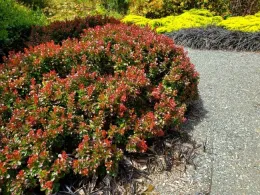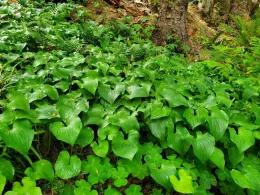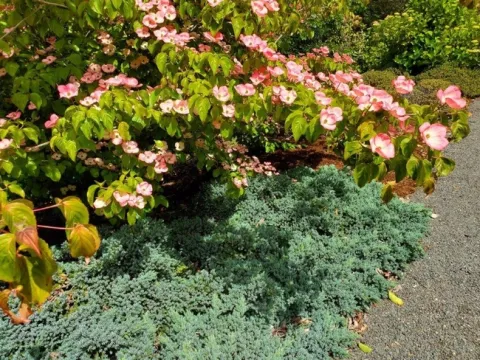
Shrubs and Bushes
Berberis thunbergii 'Bagatelle' This Japanese Barberry grows into a dense rounded shrub with red foliage that grows 2 feet by 2 feet. It generally does not need to be pruned, is deer resistant and because of its thorns it can make a good barrier planting. It is deciduous and displays attractive red twigs in winter. This is a fairly drought resistant plant for coastal gardens.
Cornus sericea kelseyi This native North American plant is also called Kelsey's red-twig dogwood. Its stature is smaller and its growth is denser than that of Cornus sericea. It has bright lime green foliage and insignificant white flowers in spring. In fall it sheds its leaves to reveal the reason for its name, bright red twigs. It is a strong grower and can be used for erosion control on steep sites. It needs little pruning but may be cut back hard in early spring to renew the red twigs. It grows 2-3 feet high and wide.
Arctostaphylos uva-ursi 'Massachusetts', commonly called bearberry or Kinninnick is a woody evergreen shrub that grows 6 to 12 inches high and 3 to 6 feet wide. In spring it has pinkish small bell shaped flowers that ripen into reddish berries. Once established it does not need irrigation. Do not fertilize. It can be grown on steep slopes in full sun, though will tolerate some shade. It will form a dense mat and spread by roots from the branch nodes. It is native throughout the northern parts of North America, Europe and Asia.
Juniperus conferta 'All Gold', This Japanese native is evergreen with soft gold foliage that grows to 6 inches tall and up to 8 feet wide. It is tolerant of poor soils, but will not thrive if soils stay wet. It is drought-tolerant once established. It needs no pruning.

Herbaceous plants
Eriocapitella hupehensis or Anemone hupehensis var. japonica You may thank or curse taxonomists for the name changes, this plant's common name is Japanese anemone. It is native to Asia. Some gardeners call it a weed as it grows and spreads where it is happy. It effectively covers the ground smothering competition and in late summer will send flowering stalks to 4 feet tall in white to pink to magenta blooms depending on the cultivar. After blooming cut back hard to the ground. On the coast it tends to be semi-evergreen. Can be grown in light shade and though it will show best with moderate irrigation, though it can tolerate a bit of drought. Deer generally don't want to eat it.
Omphalodes cappadocica, This plant is native to Turkey. It is easily grown in fertile, medium moisture, well-drained soils in part shade to full shade. It tolerates dry shade and drought. May take a bit of time to become dense, but is worth the wait as it has sky-blue forget-me-not like flowers most of the year, heaviest in spring. On the coast it is evergreen. It grows 6 to 10 inches tall and 16 inches wide. It spreads by creeping rhizomes. Though references say it may be bothered by slugs and snails we have not had that experience at HBG nor have I had trouble at home.
Helleborus orientalis Commonly called Hellebore or Lenten Rose is native to Turkey. It is an evergreen growing 1 foot tall by 1 foot wide. It blooms in early spring with white to pink flowers. You may want to cut out old leaves in fall to freshen the look and cut back spent flowering stalks. It can be grown in part shade to full shade and dry soils under trees. It tends to seed itself about so dig up the babies and move them to new locations to increase plantings. This is a tough easy to grow plant. Deer leave it alone.

Ceanothus, there are several low and dense cultivars
Epilobium canum, California Fuchsia
Juniper ‘Blue Star' or ‘Blue Chip'
Additional herbaceous plants to consider:
Bergenia crassifolia
Geranium biokovo
Dianthus allwoodii
Maianthemum dilatatum
Sedum, lots of varieties and cultivars
Ophiopogon nigricans, Black Mondo Grass
Vancouveria hexandra
Lysimachia congestiflora, various colorful forms

Site preparation and on-going weeding is essential to the establishment of an effective ground cover. Don't expect this to be a “plant it and forget it project”!
At HBG we have successfully used the Lasagna Method of site preparation in advance of planting. Here is a link to Oregon State's Publication.
Another good reference for site prep is from Missouri Botanical Garden. Humboldt Botanical Garden has had a long relationship with Missouri Botanical Garden whose principals have been great mentors for us since early in our planning and development.
UC Davis Arboretum All-Star Plant Data Base


